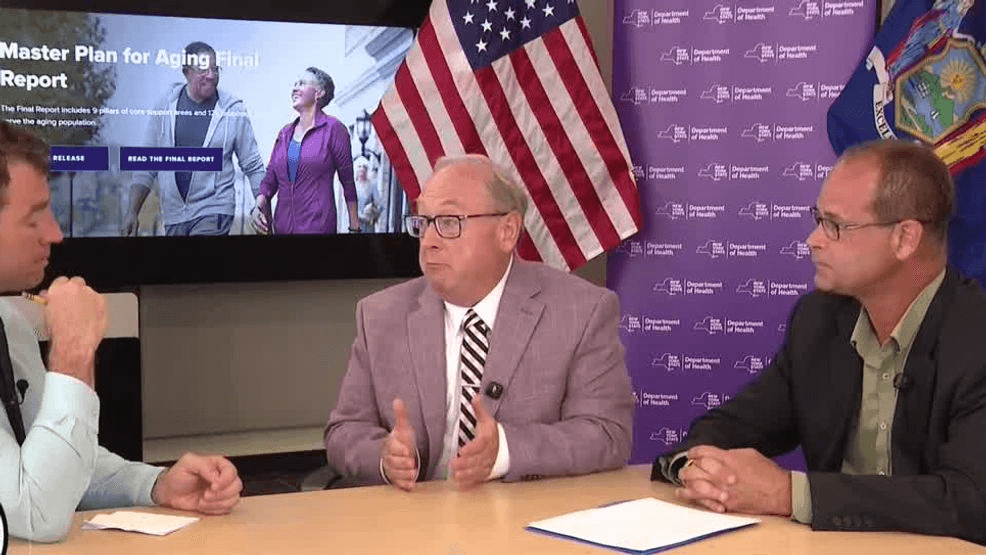Summary
NYS Commissioner of Health Dr. James McDonald and NYS Office of Aging Acting DirectorGreg Olsen broke down the recently unveiled Master Plan for Aging.
Source: WRGB CBS 6

AI News Q&A (Free Content)
Q1: What is the New York State Master Plan for Aging, and what are its primary goals?
A1: The New York State Master Plan for Aging is a strategic framework designed to address the needs and challenges of the aging population in New York. Its primary goals include enhancing the quality of life for older adults by improving access to healthcare, housing, and community support services. The plan emphasizes the importance of creating age-friendly communities and ensuring that older adults can age in place with dignity and independence.
Q2: How does the Master Plan for Aging aim to address healthcare needs for seniors in New York?
A2: The Master Plan for Aging aims to address healthcare needs by expanding access to comprehensive healthcare services tailored to seniors. This includes increasing the availability of geriatric care, promoting preventive health measures, and improving the coordination of care across different healthcare providers. The plan also focuses on integrating mental health services and ensuring that seniors receive holistic care that addresses both physical and psychological needs.
Q3: What recent developments in healthcare for seniors have been discussed in scholarly articles?
A3: Recent scholarly articles have highlighted the psychological and physical consequences of providing informal care to seniors, particularly in rapidly aging populations like China. Studies indicate that informal caregivers often face significant health challenges themselves, including increased stress and chronic diseases. These findings suggest the need for policies that support both seniors and their caregivers to ensure a sustainable and healthy aging process.
Q4: What role does the New York State Office for the Aging play in implementing the Master Plan for Aging?
A4: The New York State Office for the Aging plays a crucial role in implementing the Master Plan for Aging by coordinating with various state agencies, local governments, and community organizations. The office is responsible for ensuring that the plan's initiatives are effectively executed, which includes overseeing programs that provide support services to seniors, advocating for policy changes, and monitoring the progress of the plan's goals.
Q5: How does the Master Plan for Aging incorporate the concept of age-friendly communities?
A5: The Master Plan for Aging incorporates the concept of age-friendly communities by promoting urban planning and development that accommodates the needs of older adults. This includes designing public spaces that are accessible, safe, and inclusive, providing transportation options that are convenient for seniors, and ensuring that housing is affordable and adaptable to the changing needs of aging residents. The plan encourages communities to adopt practices that foster social inclusion and active participation of older adults.
Q6: What challenges does the aging population in New York face, and how does the Master Plan address them?
A6: The aging population in New York faces several challenges, including access to affordable healthcare, housing, and social isolation. The Master Plan for Aging addresses these challenges by proposing solutions such as expanding healthcare coverage, increasing the availability of affordable housing options, and creating community programs that encourage social engagement. The plan also highlights the importance of technology in connecting seniors with essential services and reducing isolation.
Q7: What are the potential impacts of the Master Plan for Aging on New York's economy?
A7: The potential impacts of the Master Plan for Aging on New York's economy include stimulating economic growth through job creation in healthcare and social services sectors. By investing in infrastructure that supports aging populations, the plan may also lead to increased demand for goods and services tailored to seniors. Additionally, by promoting healthy aging, the plan aims to reduce healthcare costs associated with aging-related illnesses, potentially resulting in long-term economic benefits for the state.
References:
- New York City - Wikipedia
- The hidden toll: psychological and physical consequences of providing informal care to adults in China.





